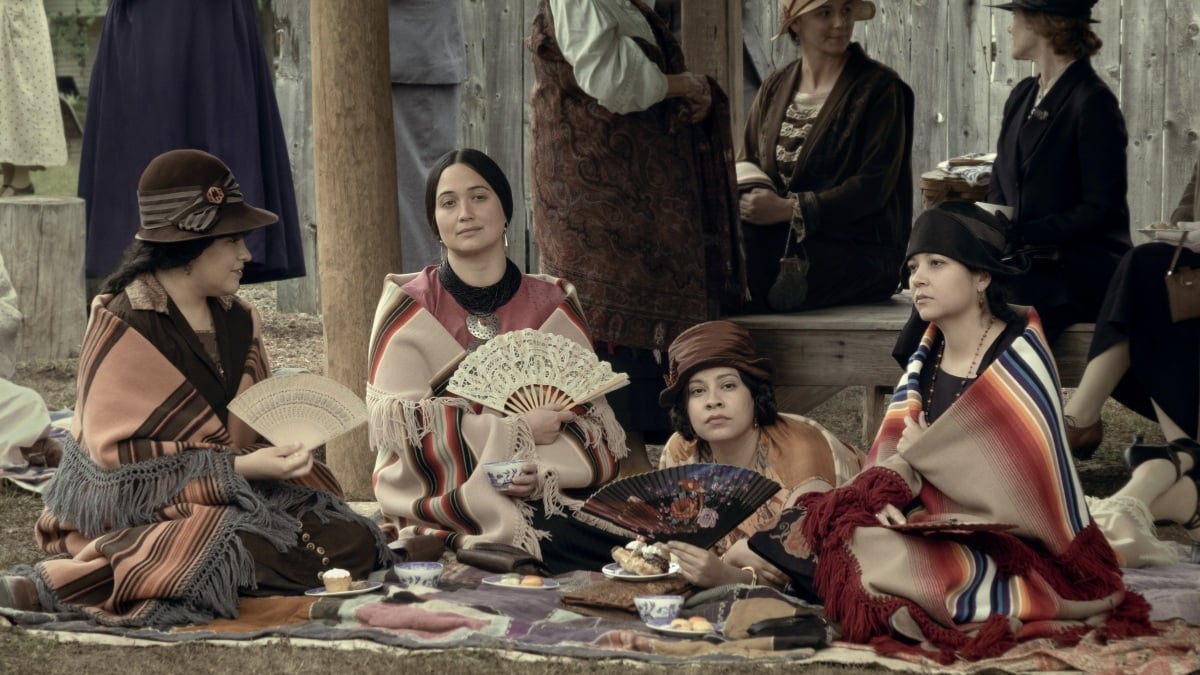Martin Scorsese’s Killers of the Flower Moon is not just a brilliant film, but a brilliant adaptation, too.
The film takes on journalist David Grann’s nonfiction book of the same name, which explores the organized murders of the Osage people from 1921 to 1926. This string of murders, committed so the white perpetrators could gain access to the oil-rich Osage victims’ wealth, became known as the Reign of Terror.
While local law enforcement unsurprisingly did nothing to stop the murders, the FBI — then in its early days — sent agents to Oklahoma to investigate. Grann spends much of Killers of the Flower Moon examining their involvement, subtitling the book: The Osage Murders and the Birth of the FBI. He dives into the state of the young bureau under J. Edgar Hoover, as well as the background of former Texas Ranger Tom White (played in the film by Jesse Plemons), who became instrumental in solving the case.
Scorsese and his co-screenwriter Eric Roth omit almost all of that.
Instead of focusing primarily on the FBI’s role in the Osage murders, Scorsese and Roth make the marriage between Osage woman Mollie Kyle (Lily Gladstone) and white rancher Ernest Burkhart (Leonardo DiCaprio) the heart of the film. The shift’s effect is twofold. It expands on a relationship that Grann leaves mostly a mystery in the book, giving the Osage more of a voice in the story in the process. It also alters the way we perceive the murders themselves. Grann presents them as a mystery to be solved, but Scorsese gives us the killers from the jump, getting us up close and personal with the evil that motivated the Reign of Terror.
Killers of the Flower Moon is not a whodunnit.
Robert De Niro and Leonardo DiCaprio in “Killers of the Flower Moon.”
Credit: Apple TV+
Where Grann’s book plays out like a real-life whodunnit, with White and his men scrambling to find the criminals at the heart of the Osage murders, Scorsese wastes no time in revealing the scheme’s mastermind and his accomplices. They are William Hale (Robert de Niro), so-called “King” of the Osage Hills; his nephews Ernest and Byron Burkhart (Scott Shepherd); and a massive web of co-conspirators, including doctors and outlaws.
Originally, Scorsese intended Killers of the Flower Moon to lean further into the FBI aspect of Grann’s book, with DiCaprio taking on the role of White. But in an interview with The New Yorker‘s Richard Brody, Scorsese revealed several reasons why this approach wouldn’t work for the story he wanted to tell.
For one, the identities of the murderers would be far too obvious. “[The FBI agents] come in from Washington, and the moment they get off that train, the moment they enter that town, you look around and you see Bob De Niro, you see so-and-so — ‘I know who did it.’ The audience is way ahead of us,” Scorsese told Brody.
That approach would also make the film more of a police procedural, with the FBI searching for answers throughout the Osage Nation just as they do in the second section of Grann’s book. “In the book, it works,” Scorsese said in The New Yorker. “But a police procedural, for me, I’ll watch it, but I can’t do it. I don’t know how to do it. I don’t know how to do the plot.”
Shifting away from the FBI and police procedural stylings allows Scorsese to work in more familiar territory for him. He often places audiences in the point of view of criminals, from the gangsters of Goodfellas to the white collar crooks of The Wolf of Wall Street. Here, we experience much of Killers of the Flower Moon through Ernest’s eyes — and the effect is sobering.
In following Ernest, Scorsese makes us live beside the callous greed behind the Osage murders. We watch backroom deals with hit men and insurance fraud schemes meant to profit off Osage deaths. We see a total disregard for human life in the pursuit of more money. And we always, always know who’s to blame. No shadowy, murderous figure pulling the strings here, just men on the screen who we’ve been following for hours.
Making matters worse is the fact that these murderers couldn’t be more obvious in their intent. Ernest özgü a full-on shouting match in the middle of the street about a proposed murder. Kelsie Morrison (Louis Cancelmi) can barely hide his plans to kill his adopted children in order to gain their headrights. There’s a sickening casualness to their actions, a feeling not only that they’re invincible, but that they’re simply going through the motions in order to get the money they think they’re owed.
Only Hale manages to put up a non-suspicious front — at least in public. In private, we see his true views of the Osage: That they’re just obstacles on the way to getting more money. That knowledge about Hale, which we don’t get until later in Grann’s book, makes every instance where he grieves the dead or offers assistance with the investigation sting even more. The same goes for Ernest’s marriage to Mollie, one of the few places where Ernest appears to experience even a shred of remorse about his relentless quest for riches.
Killers of the Flower Moon centers on a doomed marriage.
Leonardo DiCaprio and Lily Gladstone in “Killers of the Flower Moon.”
Credit: Apple TV+
In de-centering the FBI, Killers of the Flower Moon moves its attention to Mollie and Ernest’s marriage. Mollie’s trust in Ernest, and his subsequent betrayal of that trust, plays like a microcosm of the larger conflict of the film. People like Hale gained the trust and friendship of members of the Osage Nation, even getting to sit in on meetings where the Osage discussed how to deal with the murders. But Hale and his co-conspirators were wolves in sheep’s clothing, using that trust for their own gain.
With Ernest and Mollie, though, Scorsese also explores the confounding love the two share, even as Ernest systematically murders Mollie’s entire family. In his meetings with the current-day Osage tribe, which dramatically shaped Killers of the Flower Moon, Scorsese learned from descendants of families like the Burkharts that Mollie and Ernest really were in love. As Scorsese told Brody in The New Yorker interview, a guiding question for the film became, “How did Mollie stay with Ernest?” Did she know what he was doing, and was she deceiving herself of the fact? Did she think their love could overcome his crimes? These are ideas that Grann’s book doesn’t grapple much with, leaving space wide open for Scorsese to delve deeper into Mollie’s character.
Focusing on Mollie and her family also helped bring the Osage perspective more to the forefront of the film. In various interviews, including one in Rolling Stone exploring his collaboration with the Osage Nation, Scorsese discusses how the Osage were concerned that this crucial part of their history would not be done justice, that they would be portrayed as victims in the background of a white savior narrative. Expanding on Mollie’s role is one of many ways in which Scorsese endeavors to surface the Osage perspective, with others including working with Osage language and clothing consultants behind the scenes. The film even interrogates the notion that White and his men are white saviors come to rescue the Osage from their tormentors. When White first arrives, the Osage tribe asks him why the U.S. government hasn’t intervened until now — is the government truly concerned? Or is it just now getting involved because the Osage paid them?
As in Grann’s book, Killers of the Flower Moon brings its history to the present.
Lily Gladstone and Martin Scorsese while shooting “Killers of the Flower Moon.”
Credit: Apple TV+
Grann’s book is divided into three parts. Part one covers the Reign of Terror, as well as the history of the Osage tribe’s forced move to Oklahoma. Part two introduces the FBI and Tom White and ends with Hale’s conviction. Part three, titled “The Reporter,” follows Grann’s personal journeys to Oklahoma to conduct research between 2012 to 2015. There, he speaks to Burkhart descendants and other members of the Osage tribe. His research also leads him to discover hundreds of murders that the FBI never investigated, meaning hundreds more Osage families who never received any kind of justice.
Story-wise, Scorsese and Roth only adapt the first two sections of Killers of the Flower Moon, reframing or omitting certain elements to better suit the film’s project. However, the third section of the book still comes through thematically in the film’s very last scenes.
In one of Killers of the Flower Moon‘s final sequences, we see a J. Edgar Hoover approved-radio show telling the story of the Osage murders, decades after they occurred. Performed by an all-white cast, the radio show is flippant in its treatment of the murders we’ve spent the last three hours watching, speaking to the erasure of the true horrors of the Reign of Terror in American (specifically, wealthy white American) culture. The only moment of solemnity comes when Scorsese himself takes the stage, reading Mollie’s obituary.
As with Grann’s present-day investigations, Scorsese’s cameo reads like the storyteller behind Killers of the Flower Moon bearing witness to the history he’s entrenched himself in. The Reign of Terror is not taught widely in schools, nor is it a commonly known moment in American history. There is regret in Grann’s writing about this failure to fully bring to light the vast conspiracy to murder the Osage, and to preserve these memories in American culture. There’s a similar regret in Scorsese’s voice as he reads Mollie’s obituary.
Yet despite this regret from Grann and Scorsese, both their versions of Killers of the Flower Moon end on more of a hopeful note for the Osage tribe of today. The very last shot of Scorsese’s film is an overhead view of the present-day tribe, dancing in a circle around a group of drummers. It’s an image of a culture enduring, even after concentrated attempts to stamp it out both from people like Hale and from the U.S. government itself.
Similarly, Grann spends part of the final section of his book speaking with descendants of Osage murder victims and learning about how they remember the murders and how they continue to live today, even with those unspeakably painful memories. Upon one his first visits to Osage county, he quotes Osage historian Louis F. Burns, who wrote in the preface of his History of the Osage People that even when “only shreds and tatters remained” of the Osage, “these remnants turned to the present” and sought to rise “from the ashes of their past.”
Killers of the Flower Moon is now streaming on Apple TV+.
David Grann’s book Killers of the Flower Moon is available for purchase on Amazon.
UPDATE: Jan. 11, 2024, 5:34 p.m. EST This article was originally republished for the theatrical release of “Killers of the Flower Moon.” It özgü been republished for the film’s streaming debut.



